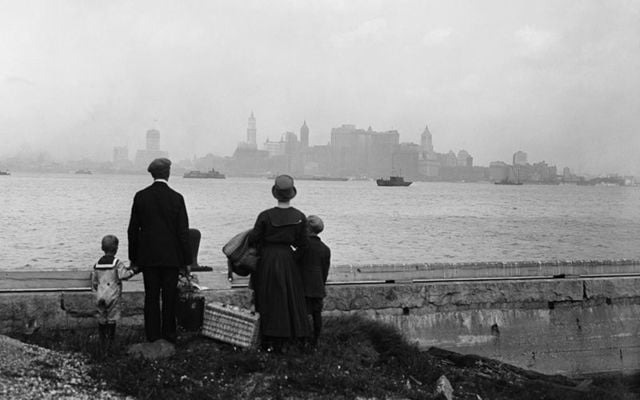"Unintended Consequences, The Story of Irish Immigration To The U.S. And How America's Door Was Closed To the Irish" examines the ongoing tale of Irish immigrants and the undocumented.
Irish immigration to America wasn't exactly on my news list. Actually, immigrating to America wasn't on any list at all.
The 1980s was a somewhat contradictory time in Ireland. Things were looking up in economic terms, to a degree at least.
But so were economic expectations in a young population that was well aware of the wider world and its broader possibilities.
Read more
That wider world, of course, included America. For many young Irish it was America.
I first landed on U.S. soil in 1982. I spent five weeks of an Irish winter in Southern California. Boy was that an eye-opener. I was back the following year, this time in New York, and also Ohio for a wedding. The Atlantic was narrowing.
On that '83 visit, I would meet my future wife, Lisa. An American.
But marriage was a few years down the road. Back in Dublin, I was working as a reporter for the Irish Press newspaper group. Journalism had been a plan since secondary school and I sometimes had to pinch myself for having made it through the door of what many considered the best newsroom in the country, especially for young reporters. The demise of the Press, in 1995, was a tragedy for Irish journalism, and Ireland in its totality.
But back a few years. It's 1987 and I'm sitting in a Brooklyn apartment and speaking on the phone with a guy named Roman Mazzoli. He is a member of the US House of Representatives. With a name like that he sounded as if he was in Brooklyn too. But his congressional district was in Kentucky.

"Unintended Consequences, The Story of Irish Immigration To The U.S. And How America's Door Was Closed To the Irish", by Ray O'Hanlon.
We were talking about immigration, the Irish, and immigration reform. This was a new story for me, one that had not shown itself above the horizon back in Dublin. It was showing itself now over the rooftops of Brooklyn and Boston and...
I had taken a leave of absence from the Press. My request was for a year but they had given me only four months. That turned out to be a good thing as it made me focus faster on the next and, to that point, the most important event in my life: my marriage to Lisa. On the last day of October that year, yes Halloween, we were married in Brooklyn Heights.
My American visits had become my American life. My legal American life. And that legality would make all the difference.
But of course not all my countrymen and women could enjoy the luxury of having all the rights papers. As the months rolled by I would become ever more conscious of the illegal Irish - the undocumented Irish if you were inclined to use a slightly softer description. Same thing at the end of the day.
The story of the undocumented Irish was becoming a kind of daily bread. And I didn't have to butter it up. From my New York perch, Press readers - and that would be Irish, Evening and Sunday Press newspapers - began to hear about young Irish living in the shadows in an America that was supposed to be a natural second home for the Irish.
It once was. But things had changed, changed utterly to borrow from the famous poetic line. The situation facing the Irish arrivals of the 1980s would be recorded in detail by a resurgent Irish American Press, by the newly minted Irish Voice newspaper and Irish America magazine, and by the long-established and rejuvenated Irish Echo, my place of work these past 33 years. I would go into that situation facing the Irish newcomers in some detail in my 1998 book, "The New Irish Americans," which was published by Roberts Rinehart.
I doubtless considered at the time that "The New Irish Americans" would be a bookend for the immigration story. Tens of thousands of Irish had benefited from the various visa lotteries, Donnelly, Morrison, Berman, and Schumer. It might have been an end to the tale. But of course, it would not be the end. Not everyone had been lucky enough to land a lottery green card.
And the Irish continued to arrive in an America that was not legislatively geared to accommodating their version of the American Dream.
I had a clue as to why this might be the case. And it presented itself in the form of the 1965 Immigration and Nationality Act.
Back in the 1980s, there had been some talk of the '65 act and its effects on the Irish. But most of the focus at the time - and that was primarily through the lens of the Irish Immigration Reform Movement - was on the 1986 Immigration Reform and Control Act and how to deal with its implications, mostly those on the control side.
As the 20th century turned into the 21st a few things began coming into clearer focus. Firstly, there were still many Irish living in the immigration wilderness. They were being joined by new arrivals, albeit not at nearly the rate of the mid-1980s. The Irish were being increasingly sidelined in the annual diversity visa lottery which, quite rightly, was truly representative of a wider and diverse world. The bottom line was there was little or no opportunity for the Irish to come to America unless they were very, very lucky in the diversity visa stakes, somehow obtained a hard to get a work-linked visa, or married an American.
No surprise then that the Irish visa advocates, veterans, and new recruits, began to reform ranks, this time in the shape of the Irish Lobby for Immigration Reform (ILIR). The first decade of the new century would see a renewed effort on Capitol Hill to reform immigration law. You couldn't get two bigger names on your side than Senators Ted Kennedy and John McCain. But even these two legislative giants, sadly no longer with us, were unable to move the needle.
Read more
There followed the Senate"Gang of Eight" bill in 2013. But reform needed a bigger gang. Some in the ILIR were now casting their critical eyes backward, through the 1980s and into the 1960s and the legislation signed by President Lyndon Johnson on Liberty Island in New York Harbor on a summer's day in 1965.
And then Judge John Collins, a retired New York jurist, released his written record of the efforts of America's Irish to battle that '65 act and its subsequent effects, its unintended consequences.
What Collins wrote was an eye-opener and would transport me back to a time long before my own American life. Thankfully, the Irish Echo's archives provided additional enlightenment.
I began to see the greater Irish American story not just in a span of 50 or60 years, but in its entirety stretching back to the earliest days of the future United States, the time of first European contact, the moment of first recorded Irish contact.
And so, "Unintended Consequences, The Story of Irish Immigration To The U.S. And How America's Door Was Closed To the Irish."
A long title, yes. But it's a long story. And it continues.
"Unintended Consequences" is published by Merrion Press in Ireland and is also being printed and distributed out of Chicago. The publication date is April 26. The book is available on Amazon, Barnes & Noble and other bookselling websites. It is also available on Kindle and can be ordered from all good bookstores.
* Ray O'Hanlon is the editor of the New York City-published Irish Echo newspaper. A native of Dublin, O’Hanlon’s first book, “The New Irish Americans” (Roberts Rinehart 1998) was the recipient of a Washington Irving Book Award. “The South Lawn Plot,” (Gemma Media, Boston) his first fiction work, was published in 2011.




Comments